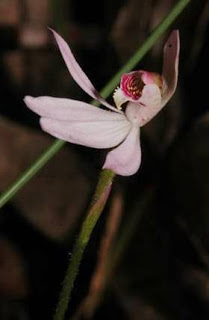Short-hooded fingers facts for kids
Quick facts for kids Short-hooded fingers |
|
|---|---|
 |
|
| Caladenia curtisepala near Fitzroy Falls | |
| Scientific classification | |
| Genus: |
Caladenia
|
| Species: |
curtisepala
|
| Synonyms | |
|
Petalochilus curtisepalus (D.L.Jones) D.L.Jones & M.A.Clem. |
|
The Caladenia curtisepala, also known as short-hooded fingers, is a type of plant in the orchid family. This special orchid grows only in south-eastern Australia. It's a ground orchid, meaning it grows in the soil. It has one fuzzy leaf and a single flower. The flower is usually white or cream-colored, with a white part called a labellum that has red stripes.
What Does the Short-Hooded Fingers Orchid Look Like?
The Caladenia curtisepala is a plant that grows from an underground tuber, which is like a small storage organ. It's a perennial plant, meaning it lives for more than two years, and it's deciduous, so its leaves fall off at certain times.
- Leaf: It has one dark green leaf that is long and thin, about 6 to 18 centimeters (2.4 to 7.1 inches) long. This leaf has a few hairs on it.
- Flower: Each plant usually has one flower. The flower is white, cream, or sometimes light pink, and it's about 14 to 22 millimeters (0.55 to 0.87 inches) wide. It grows on a stem that can be 5 to 18 centimeters (2.0 to 7.1 inches) tall.
- Sepals:
- The top sepal (called the dorsal sepal) is 8 to 13 millimeters (0.31 to 0.51 inches) long. It curves forward, forming a small hood over the center of the flower. The back of this sepal has many reddish-brown dots, which are actually tiny glands.
- The two side sepals (lateral sepals) are 11 to 16 millimeters (0.43 to 0.63 inches) long. They stick out sideways and also have similar glands on their backs.
- Petals: The petals are similar to the side sepals but are a bit shorter and narrower. They are shaped like a spear or a sickle.
- Labellum: This is a special part of the orchid flower. It's mostly kidney-shaped, white, and has many thin red stripes. It's about 6 to 7 millimeters (0.24 to 0.28 inches) long. The labellum has three main parts, called lobes.
- The side lobes stand upright.
- The middle lobe curves forward and has small, stalked teeth along its edges. It also has two rows of yellow-tipped bumps, called calli, down its middle. These bumps get smaller towards the tip.
- Column: The column is a curved, greenish part in the center of the flower. It has many irregular red stripes and wide, flat edges.
This orchid usually blooms in August or September.
How This Orchid Got Its Name
The Caladenia curtisepala was officially described for the first time in 1991 by a botanist named David L. Jones. He published his description in a scientific paper called Australian Orchid Research. The first plant used to describe this species was found at Mount Kuring-gai.
The name curtisepala comes from two Latin words:
- curtus means "short"
- sepalum means "sepal"
This name refers to the top sepal of the flower, which is shorter compared to similar orchids.
Where Does This Orchid Grow?
This type of caladenia orchid grows in areas with low shrubs and heathland. You can find it in the Central Coast region of New South Wales, Australia. It prefers to grow in soil that comes from Hawkesbury sandstone.

